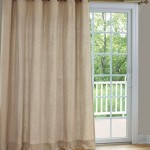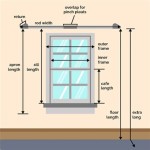Short or Long Curtains for Bedroom: A Comprehensive Guide
Choosing the right curtains for a bedroom involves considering various factors, including functionality, aesthetics, and the overall atmosphere one wishes to create. One crucial decision is the length of the curtains: should they be short, ending at the windowsill, or long, extending to the floor? Both options have distinct advantages and disadvantages, making the choice dependent on specific needs and preferences.
The purpose of this article is to provide a comprehensive guide to help determine whether short or long curtains are the more suitable choice for a bedroom. It will explore the aesthetic, practical, and functional considerations associated with each length, offering insights into how each can contribute to the overall design and comfort of the space.
Aesthetic Considerations: Visual Impact and Room Perception
Curtain length significantly impacts the visual perception of a room. Long curtains, which typically extend from the curtain rod to just above the floor, can create an illusion of greater height. This is particularly effective in rooms with low ceilings, as the vertical lines draw the eye upwards, making the space feel more expansive. The unbroken line from ceiling to floor can also contribute to a sense of elegance and formality.
Short curtains, on the other hand, generally stop at the windowsill or just below it. While they may not have the same height-enhancing effect as long curtains, they can create a more casual and less formal atmosphere. Short curtains are often perceived as being more practical and less imposing, making them a suitable choice for smaller bedrooms or rooms with a minimalist design.
The style of the curtains also plays a role in the overall aesthetic. Long, flowing curtains made of luxurious fabrics like velvet or silk can add a touch of opulence and sophistication. Conversely, short curtains in light, airy fabrics like cotton or linen can create a more relaxed and breezy feel. The choice of fabric, color, and pattern should complement the existing decor and contribute to the desired aesthetic.
Architectural features should also be taken into account. For instance, if a bedroom has particularly attractive windowsills or window frames, short curtains might be preferred to showcase these features. In contrast, if the windows are less visually appealing or if the goal is to minimize their presence, long curtains can effectively conceal them, creating a more uniform and cohesive look.
Ultimately, the aesthetic impact of curtain length is subjective and depends on personal preferences. However, understanding how each length influences the perception of space and contributes to the overall style can help in making an informed decision.
Functional Considerations: Practicality and Usage
Beyond aesthetics, the functional aspects of curtain length are crucial. Long curtains can provide superior light control and insulation compared to shorter options. The extended coverage helps to block out more sunlight, which can be beneficial for those who are sensitive to light or who prefer a darker room for sleeping. The added layer of fabric also acts as a thermal barrier, helping to keep the room warmer in the winter and cooler in the summer, potentially reducing energy costs.
Short curtains, while offering less light control and insulation, can be more practical in certain situations. They are often easier to clean and maintain, as they are less likely to drag on the floor and accumulate dust or dirt. This makes them a suitable choice for bedrooms where hygiene is a primary concern, such as children's rooms or rooms occupied by individuals with allergies.
The presence of furniture or other obstacles near the windows should also be considered. If there are radiators, bookshelves, or other items that would impede the flow of long curtains, short curtains might be a more practical solution. Long curtains that are constantly being pushed aside or bunched up can look untidy and detract from the overall appearance of the room.
Another functional consideration is safety. Long curtains can pose a tripping hazard, especially for young children or elderly individuals. Short curtains eliminate this risk, making them a safer option in certain environments. Additionally, long curtains near heat sources, such as radiators, can be a fire hazard if they are not made of flame-retardant materials.
The ease of operation is also a factor. Short curtains are generally easier to open and close, as they require less effort to move. This can be particularly important for individuals with limited mobility or those who frequently adjust the curtains throughout the day.
Therefore, the functional aspects of curtain length are determined by specific needs and circumstances. While long curtains offer superior light control and insulation, short curtains provide greater practicality and safety in certain situations.
Practical Implementation: Measuring, Installation, and Cleaning
Accurate measurement is essential for ensuring that curtains, whether short or long, fit properly and look their best. For long curtains, the measurement should be taken from the top of the curtain rod to the floor. It is important to decide beforehand how the curtains should hang: either touching the floor, slightly hovering above it (approximately half an inch), or pooling on the floor (adding several inches to the length). Each option creates a different aesthetic and has its own practical considerations. Curtains that touch the floor offer a clean, tailored look, while those that hover above the floor are less likely to accumulate dust and dirt. Curtains that pool on the floor create a more luxurious and dramatic effect, but they require more frequent cleaning.
For short curtains, the measurement should be taken from the top of the curtain rod to the windowsill or slightly below it. It is generally recommended that short curtains end about half an inch below the windowsill to avoid any unsightly gaps or overlaps. The width of the curtains should also be carefully considered to ensure that they provide adequate coverage and allow for proper pleating. A general rule of thumb is to multiply the width of the window by a factor of 1.5 to 2 to achieve a full and gathered look.
Installation is another crucial aspect of practical implementation. Regardless of the chosen length, the curtain rod should be securely mounted and positioned at the appropriate height. For long curtains, the rod should typically be placed higher than the top of the window frame to maximize the visual height of the room. For short curtains, the rod can be positioned closer to the top of the window frame.
The type of curtain hardware, such as hooks, rings, or grommets, should also be compatible with the chosen curtain rod and fabric. Different types of hardware create different draping styles and can affect the overall look of the curtains. It is important to choose hardware that is both functional and aesthetically pleasing.
Cleaning and maintenance are essential for preserving the appearance and longevity of curtains. Long curtains, due to their increased surface area and proximity to the floor, require more frequent cleaning than short curtains. Regular vacuuming can help to remove dust and dirt, while periodic washing or dry cleaning is necessary to remove stains and accumulated grime. The cleaning method should be appropriate for the fabric type to avoid damage or shrinkage. Short curtains are generally easier to clean, as they can often be laundered at home without the need for professional cleaning services.
In summary, the practical implementation of curtain length involves careful measurement, secure installation, and regular maintenance. By paying attention to these details, one can ensure that the chosen curtains, whether short or long, function effectively and enhance the beauty of the bedroom.
The ultimate decision between short and long curtains hinges on a balance between the aesthetic preferences of the homeowner, the practical needs of the space, and the ease of maintenance required. There is no universally superior choice; rather, the ideal length depends on the specific context of the bedroom and the desired outcome.

Style Debate Could Short Curtains Be The Next Big Interior Design Trend

Design Dilemma Short Or Full Length Curtains Dressingroomsinteriors

Short Curtain Living Bedroom Cafe Door Cabinet Window Drape One Panel Valance

Design Dilemma Short Or Full Length Curtains Dressingroomsinteriors

Choosing Curtains For Small Windows Exciting

How Long Should Bedroom Curtains Be Best Curtain Length

Basement Window Curtains Tips Ideas The Shade

Curtains For Short Bedroom Windows Decorating Wall Ideas Check More At Http Grobyk Com

Portfolio Liz Williams Interiors

Standard Curtain Lengths A Measuring Guide Blinds To Go








